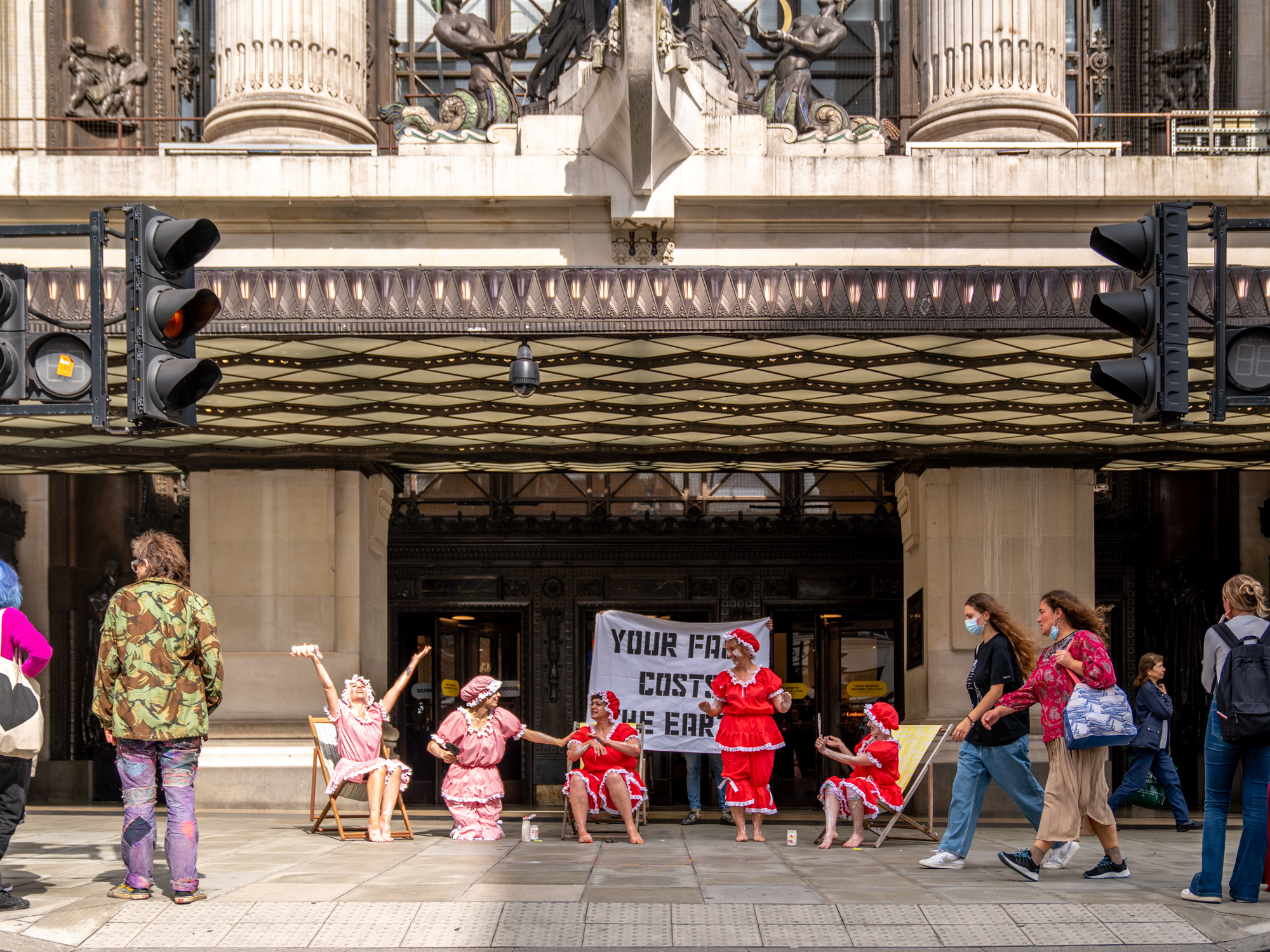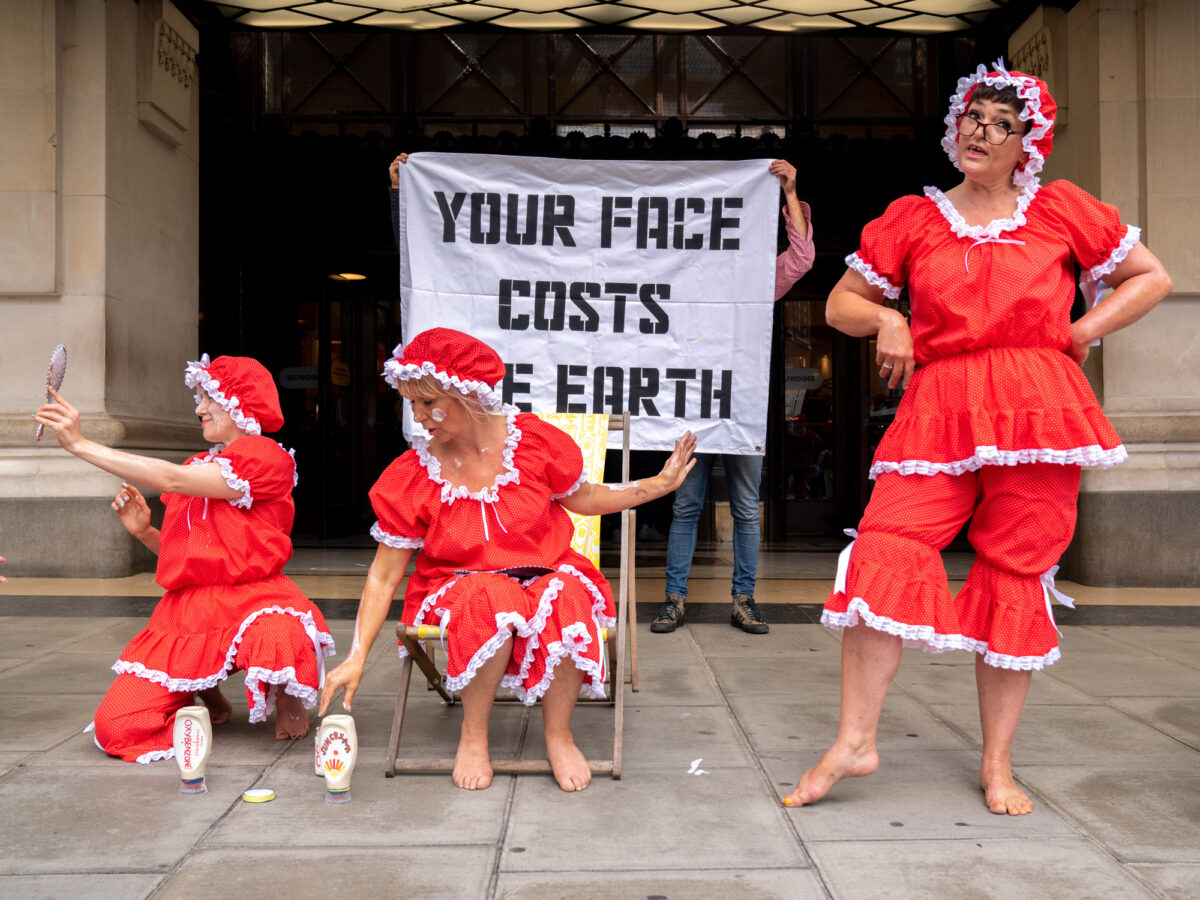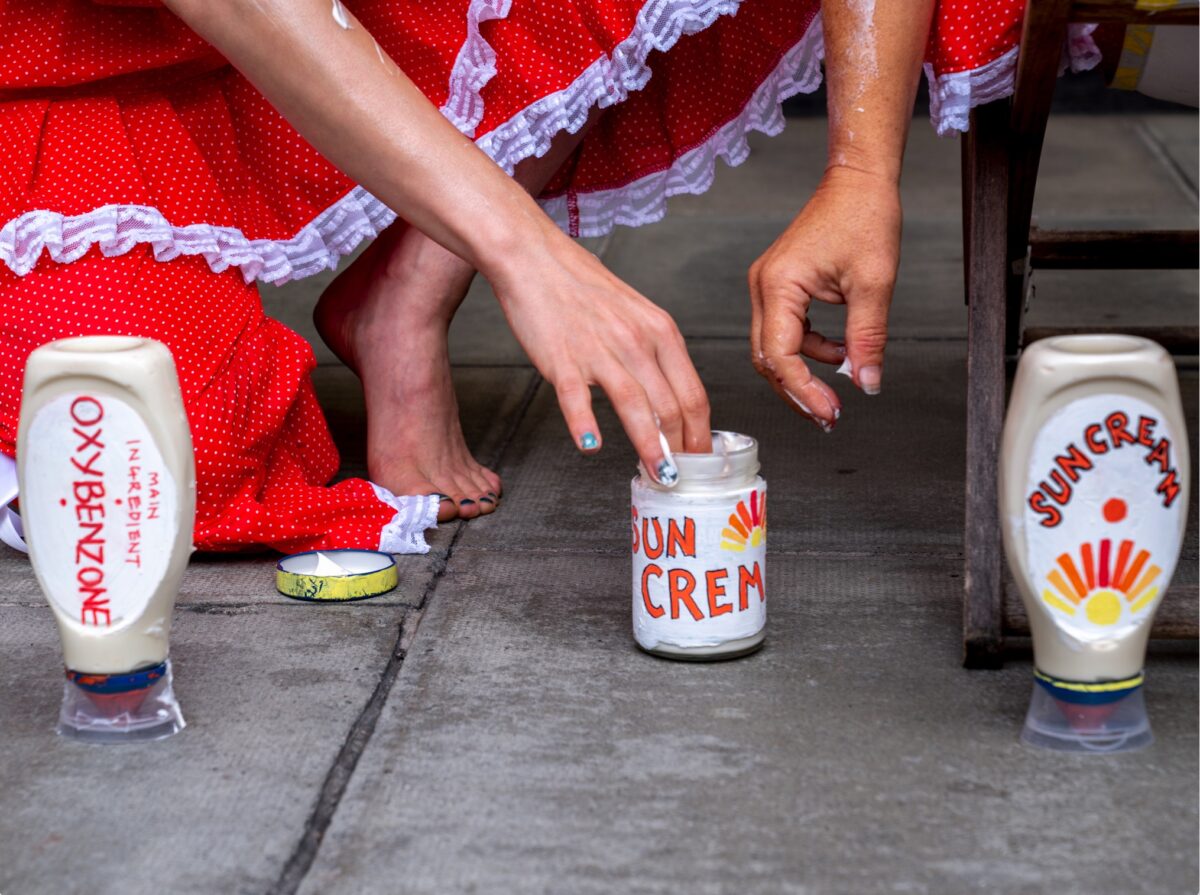YOUR FACE COSTS THE EARTH
12.09.2021

On Saturday, the 11th of September members of Ocean Rebellion staged a creative theatrical action outside the entrance to Selfridges department store on Oxford Street in London. The protest was part of their week-long calling out of the drivers of ocean degradation.
Members of the group were dressed in Victorian swimming costumes and covered their skin in ‘sun cream.’ They had banners reading ‘AS THE SEA DIES WE DIE’ and ‘YOUR FACE COSTS THE EARTH’ and were highlighting the links between cosmetics and the toxic-forever chemicals washed into the ocean down our drains, or else applied directly by swimmers wearing suncream.
Sophie Miller from Ocean Rebellion says “we demand that the government acts to ban the use of sun-screens and cosmetics containing oxybenzone and other coral-killing substances”
Rob Higgs adds “The oceans are being poisoned by the toxic chemicals routinely added to consumer items such as cosmetics and sun-screens. This is hitting the health of both the seas and the marine biodiversity that lives there.”

THE POLLUTANTS STORY
Don’t let anyone ever tell you that the solution to pollution is dilution of a toxic chemical or plastic – it isn’t!
Some toxic-forever chemicals don’t ever disappear. They don’t break down in the environment and they just keep on killing. Even when they are diluted billions of times in the oceans, it doesn’t make any difference. The reason being, is that they can get stuck onto particles of micro or nanoplastics where they get concentrated many millions or millions of times.
These tiny pieces of plastic, now loaded with the toxic chemical(s) get consumed by plants and animals, the toxins accumulate, and kill them. Researchers are now reporting that 1 in 15 of all living organisms under the surface of the waves contains plastic, and this includes everything from the largest whale, down to a cyanobacteria.
That’s why dilution is NOT a solution! There is simply no safe concentration of these toxic-forever chemicals, and if they are also oil-like and don’t want to be in solution, they form an emulsion or float on the surface like oil, and in this form, they are millions of times more toxic than chemicals that dissolve in water. One example is oxybenzone, the active ingredient in sunblock and many cosmetics. Just 5 g of oxybenzone in a bottle of sun-block will kill everything in a volume of water equivalent to 10 to 100 Olympic sized pools. 70,000 tonnes would kill everything in the oceans.
What gets us is that 20,000 tonnes of this chemical is made for adding to cosmetics, but 1,500,000 tonnes of oxybenzone is also added to plastic, paint and adhesives as a UV filter. This is one of the reasons why plastic is so toxic to marine life (make that all – life!).
Where else are these pollutants coming from?
We might immediately think that this is the fault of big industry. It sort of is, but we buy the cosmetics and cleaning products and the plastics. We go about our daily business of washing our plastic clothes, and showering & bathing and cleaning our homes with toxic chemicals. Collectively, we are quietly destroying the planet without realising it and we’re unlikely to get caught. Millions of micro and nano plastics leave our washing machines, and together with the toxic chemicals, make their way to waste water plants, which were never designed to deal with today’s modern chemistry. Oh, let’s throw in the pharmaceuticals that don’t or can’t get taken back to the pharmacy.
Around the world, only 20% of wastewater is treated, but even that to a high standard. Even in the UK, of the 9000 wastewater plants, only 1000 are designed to return water to the state in which it was originally taken for use. That means a staggering 80% of the world is dumping raw sewage into rivers, coastal waters and the oceans. But you’ll have worked out by now, despite nutrient enrichment and algal blooms, the poop and the pee are still not the main problem, it’s the forever chemicals and plastic that should be giving us all nightmares.
Finally, 80% of the microplastics come from eroding car tyres. Blown into the air, these fall on soil, ice and water and ends up in our food and our lungs, and also killing marine life everywhere. Ice turns black wth the pollutants, absorbs excess heat and melts much quicker than otherwise..


THE PLANKTON STORY
Prochlorococcus are tiny plants smaller than a 10th of a millimeter (actually, They are really bacteria) with green chlorophyll inside. They absorb carbon dioxide to make their own food. The oxygen we breathe is a by-product of their activity—that’s photosynthesis.
There are more cells of these bacterial plants or Cyanobacteria than grains of sand on the planet, and they produce 20% of all our oxygen and remove almost as much carbon dioxide.
They grow very quickly because cells divide into two cells in under 1 hour. If we piled them all together, their mass would be greater than all the produce from the Earth’s farms. It is mind boggling to think that let go wild, these tiny plants could produce all our oxygen and remove all our carbon dioxide. However, this would not be good for the oceans – and it would be miserable for us all to look at otherwise empty seas..
Thankfully, most of the Prochlorococcus and other small plants (phytoplankton) are eaten by tiny animals like copepods. Copepods are very fast swimmers and by far the fastest for their size. It might surprise you that we can only live on Earth because of all the work these tiny animals and plants do every day.
This takes a lot of imagining, there are a lot of them and that is an understatement. They are 1 mm long, but together they are equal to… … 17 million jumbo jets, weighing around 5 Giga tonnes and, and if we laid them all nose to tail, they would go around the earth 30 times.!
Crazy, right!
It doesn’t stop there. At night, all these little animals swim from a depth of 400m to the surface, and all those little legs move more water than the moon and tides. It is the greatest mass migration on the planet, and it happens, unseen by any of us, every night 24/7/365.
Now get your head around this pile of poop. Copepods eat their own body weight every day ( Can you imagine if you ate your own body weight?) and they then poop out 30 times more carbon than we humans produce by burning fossil fuels. Around 6% of this poop ends up in the abyss, and this is equivalent to around 3 Giga tonnes of carbon – that’s a lot and the IPCC don’t put into the climate change models.
This is the very scary bit: There are now less than 50% of these animals and plants living in our oceans than there were 70 years ago, and they are currently dying off at a rate of 1% year on year. In another 25 years, 80% of all life in the oceans will be gone, and along with it, the ability of ‘nature’ (those tiny plants and animals) to remove/poop carbon and produce oxygen ( photosynthesis) . We will have destroyed the life support system for planet Earth
AS THE SEA DIES WE DIE


